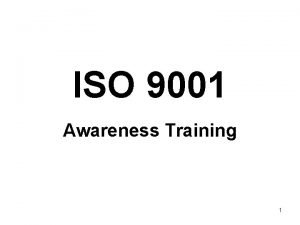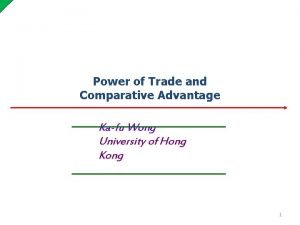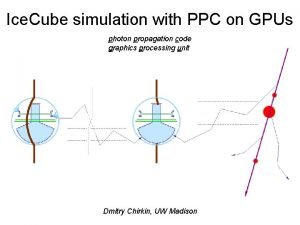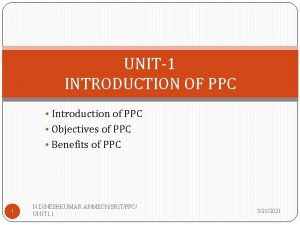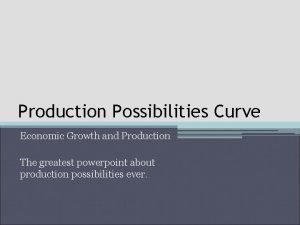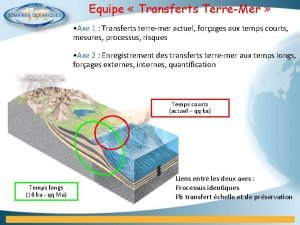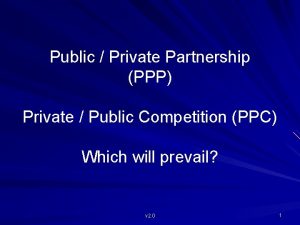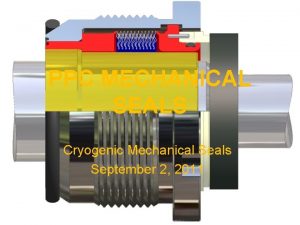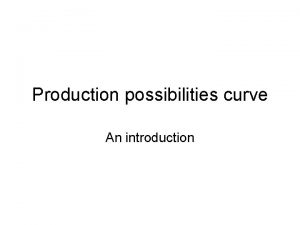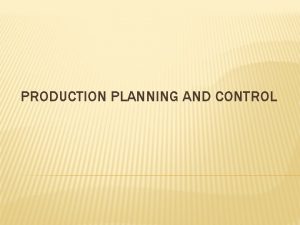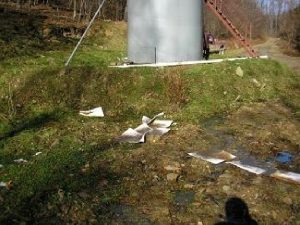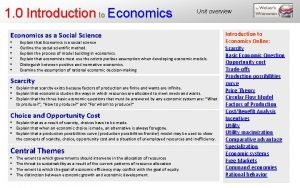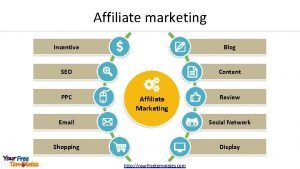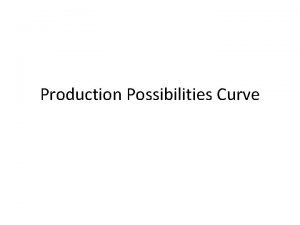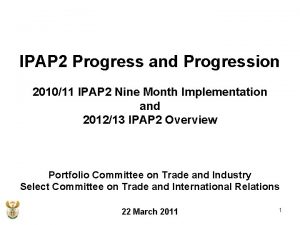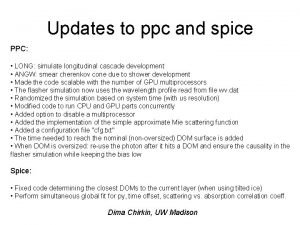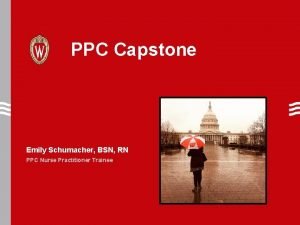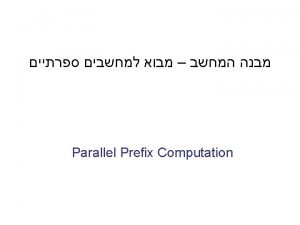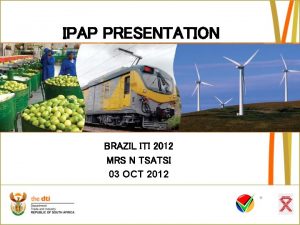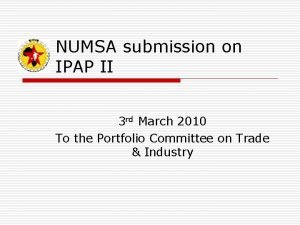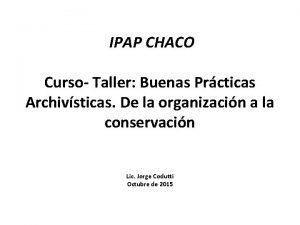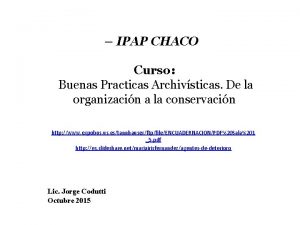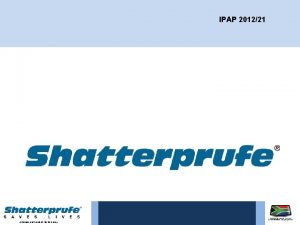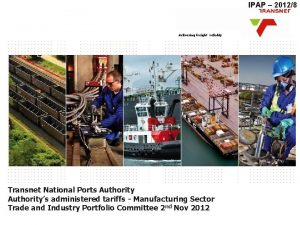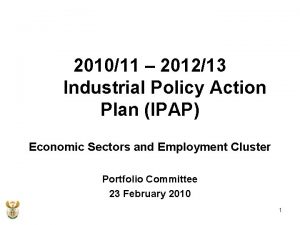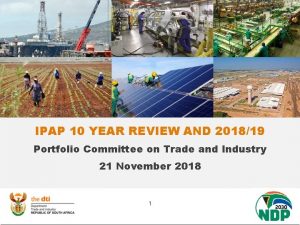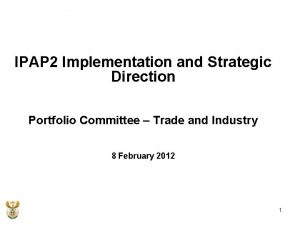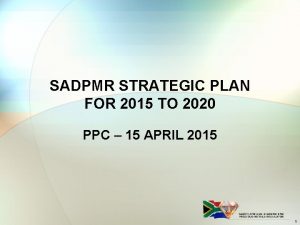2015 PPC Presentation 1 PPC Presentation 2 IPAP



































- Slides: 35

2015 PPC Presentation 1

PPC Presentation 2 IPAP 2015/16 – 2018/19 – Achievement highlights; challenges and a higher impact IPAP. Presentation to the Parliamentary Portfolio Committee of Trade and Industry – August 2015. Dr Rob Davies MP Minister Trade and Industry.

Presentation Outline 3 1. Background 2. Selected implementation highlights and strengthened industrial policy platforms: 1. 2. 3. 4. 5. 6. 7. 8. Autos Clothing, Textiles, Footwear and Leather Metal Fabrication, Capital and Transport Agro- processing Value-added services Green Economy Industrial Financing Procurement 3. IPAP 2015 – transversal and sector specific interventions – graphic summary’s 4. Challenges and conclusion

IPAP 2015/16 • IPAP 2015/16 – 2018/19 was approved by ESEID Cluster and Cabinet in April 2015. • Launched in May • This is the 6 th year of implementation of IPAP. • Priorities are: o Strengthening conditionalities and ‘packaging’ Government and DFI industrial finance support for the productive sectors of the economy. o Public procurement to support manufacturing sector, ‘crowd in’ private sector investment and reduce import leakages. o Building on significant successes and existing policy platforms in sectors such as Autos, CTLF, Metal and Engineering, Agro-processing, BPS, and Film. o Boosting new growth sectors such as in Oil & Gas, renewable energy, aerospace and defence. o Unlocking export opportunities, especially on the African continent and securing regional industrial integration 4

A higher impact IPAP Driving forces • Infrastructure-driven Industrialisation. • Resource-based Industrialisation. • Advanced manufacturing-driven Industrialisation. Levers • Packaged and conditional industrial finance. • Localisation of Public Procurement. • Localisation of Private Procurement. • Access to African market and regional industrial integration. • Regulatory efficiencies. Impact • Real value-addition and competitiveness raising • Employment • Investment • Exports • Economy-wide growth and linkages 5

Selected Implementation Highlights 6 Automotives • Light motor vehicle manufacturers: o All majors producing in SA - Mercedes Benz, BMW, Volkswagen, Toyota, General Motors, and Ford. • Auto component manufacturers: o Widespread base of sophisticated component producers including global 1 st tier, o 120 1 st tier suppliers, 75% of them multinationals, and o Over 200 2 nd and 3 rd tier suppliers, mostly local. • Auto sector has invested over R 25, 7 bn over the last 5 years: o o Mercedes Benz, R 2. 4 bn; General Motors, R 1 bn, Ford R 3. 6 bn, Metair Group R 400 m.

Selected Implementation Highlights 7 Automotives • BMW SA has just produced 1 millionth vehicle at its Rosslyn plant. • SA auto exports exceeded a record R 100 bn for 1 st time in 2014. • Vehicle quality has consistently risen: o BMW’s Rosslyn plant received the JD Power Platinum Plant Quality Award for producing models with the fewest defects or malfunctions across the globe.

Selected Implementation Highlights 8 Automotives • Medium Heavy Commercial Vehicle segment o The Automotive Investment Scheme (AIS) package has been extended to people-carriers/mini-buses, trucks and buses, and o Bus bodies have been designated for public procurement. • Within a year of its launch, the support package has directly led to new investments from companies like Iveco (Italy), Tata (India), BAW (China), Toyota (Japan), FAW (China), and Hyundai (South Korea). Some examples include: o Hyundai has begun assembling medium-duty trucks at its plant in Benoni. The R 110 million investment will create 40 new jobs. o Iveco has started production of buses for Putco with an investment of R 800 million and is expected to create about 1, 000 jobs.

Selected Implementation Highlights Automotives 9

Selected Implementation Highlights Automotives • Jobs: o 30, 000 in assembly, o 70, 000 in component manufacturing, and o 200, 000 in retail and after-sales service. • NAACAM projects that investment in 2015 will exceed 2014’s R 6, 9 bn record. NAACAM projects a new record of R 7, 49 bn in investment in 2015. • Government support has taken the industry from production of 356, 800 units in 2000 to over 566, 000 units in 2014. • Government support has grown auto exports from just 11, 000 units in 1995 to over 270, 000 units in 2014. 10

Selected Implementation Highlights 11 Automotives • Lessons from Australia: • Unlike SA, Australia rapidly liberalised its auto import tariffs and phased out its support programme (on which the fore-runner to the APDP was based). • The results - Mitsubishi, Ford and General Motors have closed their plants. • Australia’s last remaining auto producer (Toyota) will close by 2017. • The cost to its economy has led it to its Government setting up a Commission of Inquiry. • Australia’s experience is instructive – it is easy to consider SA’s support for the auto sector in the abstract. The reality is that withdrawal of government support will lead to: • The direct loss of 100, 000 jobs in assembly and components manufacture. • Given the negative impact of this to Aggregate Demand, it is likely that demand for vehicles would plummet with only about ¼ of the retail and after-sales (incl. vehicle finance) jobs remaining. • The current account deficit would balloon with the loss of over R 100 bn in auto exports and the need for all SA and Southern Africa demand for vehicles to be imported. • Given that vehicles per capita in SA and Africa remain extremely low, this would be a major economic opportunity foregone. • The target is to continue to incentivise the private-sector to grow production to 1 million units p. a. by 2020; increase exports and progressively raise local content levels and job creation.

Selected Implementation Highlights 12 Clothing, Textiles, Leather, Footwear • Between 2000 and 2010, the clothing sector lost 45, 000 jobs. • Imports (in real terms) grew four fold from just R 2, 9 bn in 2000 to over R 11 bn by 2010. • The sector was in crisis and the economy faced the real prospect of the sector losing its critical mass of technical, design and logistical capacity. • In order to stabilise the sector, the CTCP was introduced in 2010. • As at 31 March 2015, a total of R 3. 7 billion in support to the private sector had been approved since its inception in 2010. • The Manufacturing Value-addition increase attributable to the CTCP between the base of 2009 and 2014 is R 3. 9 billion, exceeding the disbursements by 50% or R 1. 3 billion. • 68, 000 jobs have been retained in the sector and 6, 900 new jobs created. The leather and footwear sector in particular has increased exports.

Selected Implementation Highlights 13 Clothing, Textiles, Leather, Footwear • In the leather and footwear segment 2, 000 sustainable jobs and a reduction of R 1. 4 bn in the sectoral trade deficit. • These interventions are leading to the revival of footwear firms which had closed under the pressure of imports. • Kayo Shoes reopened in Dimbaza, Eastern Cape in April 2015, resuscitating 417 jobs. • A new leather tannery Fusion Leather was established in Atlantis, Cape Town. • Angel Shoes reopened in Cape Town.

Selected implementation highlights. Clothing, Textiles, Leather & Footwear • Higher impact IPAP: o National and regional clusters are working well bringing together textile manufacturers; apparel manufacturers, retailers and labour together to achieve significant competitive capabilities and advantages – quick turn-around fast fashions; niche products and supplier development o With stability achieved, Business (including retailers), Government and Labour are partnering to position the sector for sustainable growth. 14

Selected Implementation Highlights 15 Metal Fabrication, Capital and Rail Transport Equipment • These sectors are vital components of modern economies with practically every other economic sector dependent on it for the ‘tools’ to operate. Put simply, this sector produces the machines which other sectors use to produce their goods and services. • The designation of valves has led to foreign investment by Denmark AVK which has acquired South Africa’s Premier Valves Group (PVG) for R 100 million. Denmark AVK will fund the introduction of a new international standard for local production capability at the facility, in support of the dti’s designation policy. • The Premier Valves Group (PVG) itself is committing to investing R 5 - million in support of valve designation, having already invested more than R 6 -million in associated equipment over the last three years.

Selected Implementation Highlights 16 Metal Fabrication, Capital and Rail Transport Equipment • US technology multinational General Electric (GE) announced a R 700 million commitment designed to support innovation, enterprise- and skills -development in South Africa. R 500 -million will be invested in the creation of a customer innovation centre and R 200 -million in a supplierdevelopment vehicle to provide technical, funding and business support to SMEs. • On the back of dti’s support of R 11 million Grindrod unveiled its cost- effective shunting and short haul locomotive in October 2014. The locomotive boasts 80% local content and is already being exported to a number of African countries with after sales service centres in these countries. • In related upstream oil and gas sector Hunting Energy Services (International) Ltd opened a R 400 million construction facility in Cape Town.

Selected Implementation Highlights 17 Metal Fabrication, Capital and Rail Transport Equipment • However, this value-chain’s competitiveness has been substantially eroded by electricity price increases (including additional municipality levies), electricity supply challenges, import competition, and increasing competition on export markets due to the slump in global mining. • Higher impact IPAP o In view of the severe distress that some parts of the sector are in, R 300 m has been earmarked from the dti’s MTEF allocation but further funds will be required from the Economic Competitiveness Support Fund package. o In addition, the further designations announced by Minister of Trade & Industry will be used to support the manufacturing sector and ‘leverage in’ private-sector investment to supply the infrastructure build programme.

Selected Implementation Highlights 18 Agro-processing • Since 2009 the dti has supported agro-processing industries to the value of R 1. 2 billion through various schemes such as the MCEP and EIP. • In addition, in FY 2014/15, the Aquaculture Development and Enhancement Programme (ADEP) supported 8 projects, with an incentive value of R 75 million. This has leveraged private-sector investment of R 96 million. • Coega Development Corporation and the dti have partnered to create an R 86 million agro-processing facility within the IDZ. • the dti and JSE-listed Astral Foods partnered in a R 200 million feed mill in Standerton to boost South Africa’s agriculture sector. • Higher Impact: One of the challenges identified by DAFF and DRDLR is the difficulty in drawing in smallholder farmers into the procurement processes of the large Agro-processors. In order to unlock the synergies between the IPAP and the APAP, the dti will develop an Agro-processing and Smallholder Agriculture Linkage support programme – aligned to the Agri-Park initiative. Seed funding has already been secured within the dti to kick-start the programme.

Selected Implementation Highlights 19 Green Economy • the dti has strengthened the local content requirements for renewable energy. It progressed from a threshold of 25% in bid window 1 to a threshold of 40% in bid window 4. These local content requirements have resulted in a number of new investments in local manufacturing: o SMA Solar Technology South Africa, officially launching its multi-million Rand manufacturing facility in Cape Town. o Jinko Solar opening its R 80 million, 120 MW solar PV plant. o A R 1. 5 -billion, 100 -hectare solar power photovoltaic (PV) plant facility was launched at Droogfontein near Kimberly. It is the first large solar farm in South Africa to be built as a direct response to the REIPPPP. o On the IPP side, a number of South African Companies are actively participating – one such being Pele Green Energy, a 100% black-owned South African Independent Power Producer which builds, owns and operates renewable energy projects and has been granted preferred bidder status on three renewable energy projects in Round 3 of the REIPPPP.

Selected Implementation Highlights 20 Value-added Services • the dti launched the revised Business Process Services (BPS) incentive at South Africa House in London. • The revised incentive scheme will build upon the success of the previous scheme which led to the creation of 9, 077 jobs on the back of financial disbursements of R 587 million. • Webhelp, a French-owned Global Contact Centre company, launched its new Johannesburg Contact Centre in August 2014. The investment is expected to rise to more than R 220 m over three years and has thus far created 200 jobs. • CCI Call Centres has invested R 200 m in Umhlanga, KZN which will increase the jobs created from 3, 000 to 5, 500.

Selected Implementation Highlights 21 Industrial Finance and Investment • Access to industrial finance at competitive rates is a critical determinant of industrial investment and growth: • Foreign Investment o Between January 2013 and December 2014, SA attracted approximately R 57. 9 billion from 153 companies. These investments created 19, 706 jobs. • Manufacturing Competitiveness Enhancement Programme o FY 2014/15: 236 enterprises were approved for funding under MCEP with a total grant value of R 1, 1 bn. This has leveraged private-sector investment of R 3, 7 billion in support of 28, 093 jobs.

Selected Implementation Highlights 22 Industrial Finance and Incentives • 12 i Tax Incentive o FY 2014/15: 17 enterprises were approved for funding with a total tax allowance of R 2, 7 bn. This has leveraged private-sector investment of R 6, 7 bn in support of the creation of approximately 4, 500 jobs. • Enterprise Investment Programme o FY 2014/15: 39 enterprises were approved for funding with a total grant value of R 147 m. This has leveraged private-sector investment of R 1, 3 bn in support of the creation of approximately 1, 500 jobs. • Technology and Human Resource for Industry Programme (THRIP) o Since 2009 to December 2014, THRIP has approved 1, 602 projects to the value of R 873 m and supported 9, 750 students.

Selected Implementation Highlights 23 Industrial Finance and Investment • National Empowerment Fund (NEF) o Approvals: The NEF Approved 549 transactions worth more than R 5. 4 billion for black-empowered businesses across the country, supporting over 47, 000 jobs. • Between April 2014 and December 2014, IDC approved projects to the value of R 7, 7 billion with 6, 899 jobs were created and 4, 668 jobs saved. • The following IPAP sectors benefitted from the approvals: o o o o o R 283 million in Agro Industries R 478 million for Chemical & Allied Industries R 352 million for Forestry and Wood Products R 1, 4 billion for Green Industries R 46 million in Media & Motion Pictures R 323 million in Metal, Transport & Machinery Products R 3 , 3 billion in Mining and Minerals Beneficiation R 678 million in Shipbuidling R 433 million in Textiles

Selected Implementation Highlights Industrial Finance – 12 I Tax Allowancep April 2014 to March 2015 Ironveld Smelting - R 610 m m PPC – R 1, 4 bn n Mpact – R 157 m ① Mpact – R 350 m ② Amka – R 393 m ③ Premier Valves – R 31 m ④ Nampak Food Division– R 120 m ⑤ Nampak Alu Division – R 705 m ⑥ Nampak Bevcan – R 440 m o Air. Liquide – R 2, 3 bn ⑩ Parmalat – R 137 m k Mpact Plastics – R 54 m l Saldanha Steel - R 1, 3 bn ⑥ Bakhresa – R 504 m ⑦ Afrox – R 348 m ⑧ Tiger Brands – R 73 m ⑨ Afrox R 320 m

Securing a higher impact IPAP 25 Industrial Finance and Investment • Higher impact IPAP o Need for attaching stronger conditionality's (competitiveness raising; BBBEE, supplier development and localisation etc. ) in existing incentive programmes, o Roll-out of the Black Industrialists Programme. o Development of new sector-specific incentive schemes which have proved to be effective in leveraging investment e. g. — Metal and Engineering sector support programme, and — Agro-processing and Smallholder Agriculture Linkage support programme which will also support Agri-Park initiative. o Development of a new incentive to support greenfield investment (12 I is limited to investment of R 50 m and above).

Securing a higher impact IPAP 26 Procurement localisation • In total 16 products or sectors have now been ‘designated’ for localisation in government procurement. • This includes Designations (with Instruction Notes to follow from NT): o Steel conveyance pipes; o Transformers; o Power line hardware and structures; o Mining and construction vehicles; o Two way radios; and o Building and construction materials. • Given the R 3, 6 trillion infrastructure build programme, a failure to localise would lead to substantial import leakages with significant negative impact for the balance of trade and industrialisation efforts.

Securing a higher impact IPAP 27 Procurement localisation • Rail fleet procurement o PRASA and Gibela Rail Transportation announced that the entities had achieved commercial close on the contract to supply the state agency with 600 commuter trains (3, 600 coaches) over the next ten years. The R 51 billion contract to supply the trains was signed in October 2013. The Gibela deal forms part of PRASA’s bigger rolling stock programme, which aims to procure 7, 224 new coaches at a projected cost of R 123 billion over 20 years. o PRASA has awarded a tender to Alstom for the manufacturing of 7224 coaches to be built between 2015 and 2025, the initial phase is estimated to create over 8000 direct jobs. o Transnet has awarded a total of R 50 bn in contracts to CSR Zhuzhou Electric Locomotive, CNR Rolling Stock SA, Bombardier Transportation SA and General Electric SA for the building of 1, 064 electric and diesel locomotives to be built in SA. All the locomotives, except for 70, will be built in Transnet Engineering’s plants in Pretoria & Durban.

2. 5 Implementation Progress Procurement localisation (designations) • Rail fleet procurement 28

Securing a higher impact IPAP 29 Procurement localisation • Heavy Commercial Vehicle Procurement – Bus Designation. o Volvo Southern Africa, in partnership with Marcopolo South Africa, has been contracted to produce 131 buses - 85 rigid 12 m and 46 articulated 18 m vehicles - to the City of Tshwane by 2016. Mercedes-Benz South Africa (Sandown Motor Pty Ltd) won the tender to provide 134 busses for the phase 1 B of the City of Johannesburg’s Rea Vaya rapid bus system. The City of Cape Town awarded Volvo South Africa a tender to provide 40 busses for the extended My. Citi rapid bus routes at a cost of R 180 m. Tshwane Municipality has awarded MAN a tender to supply 120 A 84 Lion’s City busses. o Procurement - Higher Impact IPAP: It is critical that compliance (across government departments, spheres of government, SOE’s and agencies) to all the procurement policy levers (Designations; Competitive Supplier Development Programme (CSDP); amended regulations of the PPPFA; NIP) o Securing better alignment – e. g. Mining Charter. o Compliance audit function to be implemented. o Monitoring of all public sector tenders – non-compliance hotline. o Securing much stronger private sector support for local supplier development especially large corporations with significant procurement spend e. g. ; mining companies.

2015 IPAP 2015 – Graphic Summary IPAP: TRANSVERSAL FOCUS AREAS 30

2015 IPAP 2015 – Graphic Summary IPAP: SECTORAL FOCUS AREAS 1 31 TRADITIONAL SECTORS AND VALUE ADDING SERVICES

2015 IPAP 2015 – Graphic Summary IPAP: SECTORAL FOCUS AREAS 2 MINERALS AND ENERGY 32

2015 IPAP 2015 – Graphic Summary IPAP: SECTORAL FOCUS AREAS 3 ADVANCED, ELECTRONIC & NICHE SECTORS 33

Challenges 34 • A bottle-neck busting and solutions based approach to key challenges is required; • Electricity supply; pricing and problems at municipality level. • Localisation/Designations – non-compliance, across various tiers of government and Departments. • Port tariffs and rail and ports inefficiencies – re-balancing and improvements. • Industrial finance – further Economic Support Package funds need to be allocated to unlock private-sector investment and catalyse industrialisation. • ‘Red tape’ – administrative constraints

PPC Presentation 35 Conclusion • IPAP 2015 is the sixth iteration of the Industrial Policy Action Plan. • Implementation in the face of very significant headwinds – great • • global recession and domestic constraints. Evidence demonstrates that where interventions are well researched, designed and managed; are adequately resourced and are the subject of close collaboration and alignment between stakeholders there are considerable achievements and policy platforms which can be built upon. IPAP is a very important tool for management, planning and oversight. It is critical that compliance across and between government departments, spheres of government and SOE’s is secured in a national industrial effort. There are no short-cuts – continuous improvement, learning by doing, strengthening the capacity of the state and strengthening stakeholder engagement and relations are critical factors.
 Ipap chaco
Ipap chaco Iso 9001:2015 awareness presentation ppt
Iso 9001:2015 awareness presentation ppt Iso 9001 presentation
Iso 9001 presentation Outward shift in ppc
Outward shift in ppc Nvidia ppc
Nvidia ppc Ppc search engine marketing positioning
Ppc search engine marketing positioning Objective of ppc
Objective of ppc 3 shifters of ppc
3 shifters of ppc Promovare ppc
Promovare ppc Ppc curve economic growth
Ppc curve economic growth Ppc in economics
Ppc in economics Ppc=pam-pic
Ppc=pam-pic Monitoreo de pic en uci
Monitoreo de pic en uci Campagne ppc martinique
Campagne ppc martinique Gopresto.com/ppc/rocking
Gopresto.com/ppc/rocking Ppc for higher education
Ppc for higher education Ppc mechanical seals
Ppc mechanical seals Production possibilities frontier quiz
Production possibilities frontier quiz Opportunity cost graph
Opportunity cost graph Production possibilities curve
Production possibilities curve Campanie ppc
Campanie ppc Ppc media
Ppc media Ppc training slides
Ppc training slides Dragos smeu
Dragos smeu Sean marshall ppc
Sean marshall ppc Inventory in ppc
Inventory in ppc Audit ppc bucuresti
Audit ppc bucuresti Ppc for manufacturing
Ppc for manufacturing Ppc
Ppc What is ppc plan
What is ppc plan Straight line ppc
Straight line ppc Straight line ppc
Straight line ppc Ppc seo and affiliate programs
Ppc seo and affiliate programs Diagram of production possibility curve
Diagram of production possibility curve Cjrae cluj
Cjrae cluj Processi cognitivi
Processi cognitivi


